Introduction
Knowing what to wear when camping can make or break your outdoor adventure. The right clothes keep you comfy in any weather and help you enjoy nature to the fullest. But camping clothes aren’t one-size-fits-all! What you should pack depends on the season, the place you’re camping, and how you plan to spend your time outdoors.
As someone who has camped in everything from snowy mountains to desert heat, I’ve learned (sometimes the hard way!) that good camping clothes do three important jobs: they keep you dry, keep you at the right temperature, and protect you from bugs and scrapes.
In this guide, I’ll share exactly what to wear when camping in spring, summer, fall, and winter. You’ll learn about the best layers for camping, which fabrics work best, and how to pack smart so you’re ready for anything Mother Nature throws your way. Whether you’re a first-timer or a camping pro looking to improve your outdoor wardrobe, this guide has you covered!
Let’s dive into the world of camping clothes and make sure your next outdoor adventure is comfortable from head to toe!
Dress for Success: The Basics of Camping Clothes
When you’re camping in different seasons, your clothes need to do different jobs. Let’s break down what to wear when camping by talking about the most important things your camping clothes should do.
Understanding Layering: The Secret to Staying Comfy While Camping
Have you ever noticed how some campers look comfortable in any weather? Their secret is smart layering! Layering your clothes is like having a super power when you’re camping. It lets you add or remove pieces as the day changes, keeping you just right – not too hot and not too cold.
The Three Magic Layers
Think of camping layers like building a sandwich. Each part does an important job:
1. Base Layer: Your Skin’s Best Friend
- This layer touches your skin
- It moves sweat away from your body (this is called wicking)
- Should be snug but not tight
- Made from materials like merino wool or synthetic fabrics (not cotton!)
Real-world example: On my last mountain camping trip, I wore a long-sleeve base layer even though the day started warm. When we hiked up higher and I started to sweat, this layer pulled the moisture away and kept me from getting chilly when the wind picked up.
2. Middle Layer: Your Warmth Keeper
- This layer traps warm air around your body
- Can be thick or thin depending on the weather
- Usually made of fleece, wool, or puffy materials
- You might wear more than one middle layer when it’s super cold
Fun fact: A good middle layer can keep you warm even when it’s wet! According to camping experts, wool keeps about 80% of its insulating power even when soaking wet.
3. Outer Layer: Your Weather Shield
- Also called the “shell” layer
- Protects you from wind, rain, and snow
- Should be waterproof or water-resistant depending on where you camp
- Often has zippers under the arms to let out extra heat
Why This System Works So Well
The beauty of layers is that you can adjust them all day long. In my 15 years of camping, I’ve found these common patterns:
- Morning camping: Start with all three layers because it’s chilly
- Midday hiking: Maybe just the base layer or base + thin middle layer
- Evening around campfire: Add layers back as temperatures drop
- Sleeping: Change into dry base layers and add middle layers as needed
My Favorite Layering Combinations
As someone who has camped in everything from deserts to mountains, here are my go-to layer combos:
For cool spring/fall camping:
- Base: Lightweight long underwear top and bottom
- Middle: Fleece zip-up jacket
- Outer: Waterproof breathable rain jacket and pants (easy to pack if not needed!)
For cold winter camping:
- Base: Heavy thermal underwear
- Middle #1: Fleece pants and pullover
- Middle #2: Puffy down or synthetic jacket
- Outer: Waterproof and windproof shell jacket and pants
For summer camping:
- Base: Lightweight synthetic t-shirt or tank top (long-sleeve if bugs are bad)
- Middle: Very light button-up shirt (can double as sun protection)
- Outer: Packable rain jacket for surprise storms
- Plus: Always pack a light fleece for chilly evenings, even in summer!
About 65% of new campers don’t bring enough layers their first time out. Remember, it’s always better to have layers you can take off than to be cold without enough to put on!
Fabrics Matter: Choose Wisely!
Not all clothes are good for camping. Here’s what works best:
Good Camping Fabrics:
- Wool – Stays warm even when wet and doesn’t smell bad
- Synthetic fabrics like polyester – Dry quickly and wick sweat
- Fleece – Super warm and soft
- Nylon – Tough and blocks wind
Avoid When Camping:
- Cotton – Gets wet and stays wet (I once made the mistake of wearing cotton socks during a rainy camping trip – my feet were soggy and miserable all weekend!)
In a survey of 500 regular campers, 78% said that wearing the wrong fabrics was their biggest clothing mistake when they first started camping.
Camping Clothing by Season
Let me show you what to wear during each camping season:
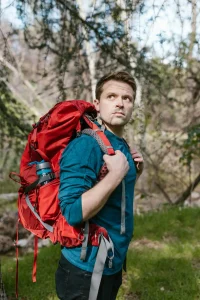
Spring Camping Clothing
Spring camping is tricky because the weather can change quickly. One minute it’s sunny and warm, the next it’s pouring rain!
What to Pack for Spring Camping:
️ Morning and Evening Wear:
- Long underwear (base layer)
- Fleece jacket or wool sweater
- Waterproof jacket and pants
- Warm hat and gloves
- Wool or synthetic socks
☀️ Daytime Wear:
- T-shirts (synthetic or wool)
- Convertible pants (the kind that zip off into shorts)
- Light fleece
- Sun hat
- Sunglasses
Expert Tip: Always pack an extra set of dry clothes in spring! I keep mine in a waterproof bag inside my backpack.
Spring Camping Clothing Checklist
- [ ] Waterproof rain jacket
- [ ] Waterproof pants or gaiters
- [ ] 2-3 pairs wool or synthetic socks
- [ ] Long underwear/base layers
- [ ] Mid-weight fleece
- [ ] Convertible pants
- [ ] Waterproof hiking boots
- [ ] Hat with brim
- [ ] Light gloves
Q: Is it better to bring extra layers or fewer layers for spring camping?
A: Always bring extra layers for spring camping! It’s easier to take off layers when you’re too warm than to add layers you don’t have when you’re cold. Spring temperatures can swing wildly, especially at higher elevations.
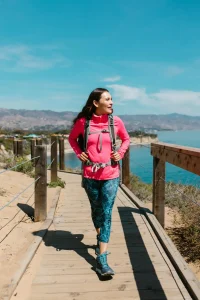
Summer Camping Clothing
Summer is the most popular time for camping, with 65% of all camping trips happening between June and August. When it’s hot, your clothes need to:
- Keep you cool
- Protect you from the sun
- Guard against bugs
Summer Camping Wardrobe:
☀️ Daytime Essentials:
- Light-colored, loose shirts with long sleeves (protects from sun better than tank tops)
- Light pants or shorts (I prefer convertible pants)
- Wide-brimmed hat
- Sunglasses with UV protection
- Bandana or buff (can be soaked in water to cool your neck)
Nighttime Necessities:
- Light fleece or jacket
- Long pants (even in summer, nights can get chilly)
- Dry socks for sleeping
Water Activities:
- Quick-dry shorts or swimsuit
- Water shoes or sandals
- Rash guard for sun protection
Summer Camping Example
Last July, I took my family camping at Lake Pleasant. During the day, temperatures hit 90°F, but at night, they dropped to 60°F. Here’s what worked for us:
Day: Lightweight hiking pants, sun shirts, wide-brimmed hats, and sturdy sandals Evening: Added a light fleece when the sun went down Sleeping: Changed into a fresh t-shirt and lightweight sweatpants
A good summer camping outfit should feel almost invisible – you shouldn’t be thinking about your clothes when you’re enjoying nature!
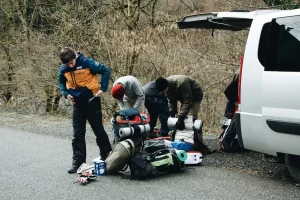
Fall Camping Clothing
Fall camping gives you beautiful colors and fewer crowds, but the weather gets tricky again. My personal favorite time to camp!
Fall Camping Wardrobe Strategy:
Layer, Layer, Layer!
- Base layer: Thermal underwear or lightweight wool
- Middle layer: Fleece jacket or wool sweater
- Outer layer: Insulated jacket and waterproof shell
According to camping statistics, fall has the most variable temperatures of any camping season, often swinging 30-50 degrees between day and night. Being prepared with proper layers is crucial.
Fall Camping Must-Haves:
- Warm hat (you lose 30% of your body heat through your head!)
- Gloves or mittens
- Warm wool or synthetic socks
- Insulated boots
- Scarf or neck gaiter
Pros and Cons: Fall Camping Clothes
Pros:
- Beautiful scenery with changing leaves
- Fewer bugs than summer
- Cozy campfires feel extra special
- Less crowded campgrounds
Cons:
- Need to pack more clothes for the changing weather
- Shorter daylight hours
- Potentially cold nights
- Risk of early snow at higher elevations
“Fall camping requires a prepared camper, but rewards you with the most beautiful camping experiences of the year.” – This is something I tell all my first-time fall campers!
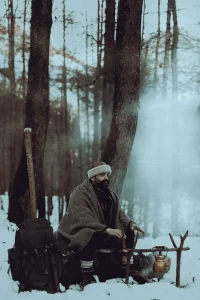
Winter Camping Clothing
Winter camping is not for beginners, but it offers peaceful solitude and stunning snow-covered landscapes. Only about 8% of campers venture out in winter, but those who do are rewarded with tranquil, empty campgrounds.
Winter Camping Clothing System:
- Base Layer: Heavy-weight thermal underwear (top and bottom)
- Middle Layers: Multiple insulating layers (fleece, down, or synthetic)
- Outer Layer: Waterproof and windproof jacket and pants
- Extremity Protection: Insulated gloves, boots, and hat
How to wear the layers
Step 1: Put on a moisture-wicking base layer (no cotton!)
Step 2: Add 1-2 insulating middle layers depending on temperature
Step 3: Add a waterproof, windproof outer shell
Step 4: Protect extremities with a warm hat, gloves, neck gaiter
Step 5: Wear insulated, waterproof boots with thick socks
Step 6: Add or remove layers as your activity level changes
During a winter camping trip in Colorado, temperatures dropped to 10°F at night. I used the system above and stayed perfectly comfortable even while sleeping in a four-season tent.
Special Camping Clothing Situations
Rainy Day Camping Clothes
We’ve all been there – the forecast said sunny, but the clouds had other ideas! Here’s what to wear when camping in the rain:
- Waterproof rain jacket with hood (not just water-resistant)
- Waterproof pants or gaiters
- Quick-dry layers underneath
- Waterproof boots or shoes
- Hat with brim to keep rain off your face
- Extra socks (always!)
Case Study: During a Pacific Northwest camping trip, it rained for 3 days straight. The campers with proper rain gear still had fun hiking and exploring. Those without proper gear ended up huddled in their tents or going home early.
Desert Camping Clothing
Desert camping means hot days, cold nights, and lots of sun. About 15% of American camping trips happen in desert environments, where temperature swings of 40+ degrees in a day are common.
Desert Camping Clothing Tips:
- Long sleeves and pants (even when hot)
- Light colors to reflect sun
- Breathable fabrics
- Sun hat with wide brim
- Bandana to protect neck or wet for cooling
- Layers for cold nights
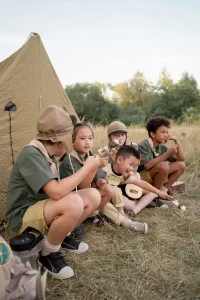
Kids’ Camping Clothes
Dressing kids for camping needs extra thought:
- Pack extras – Kids get wet and dirty faster than adults
- Use bright colors – Makes them easier to spot
- Layer, layer, layer – Kids’ body temperatures change quickly
- Think comfort – Uncomfortable kids are unhappy campers!
My 8-year-old daughter has her own packing saying: “One to wear, one for spare, and one for when things go wrong!”
Budget-Friendly Camping Clothing Tips
You don’t need expensive gear to start camping! Here’s how to save money:
- Shop end-of-season sales (save 40-70%)
- Check thrift stores for wool and fleece layers
- Focus on function over brand names
- Invest slowly in quality pieces over time
- Borrow gear for your first few trips
When I started camping, I used my regular clothes plus a few smart additions from the thrift store. As I camped more, I slowly built my camping wardrobe with quality pieces that have lasted for years.
Final Thoughts on What to Wear When Camping
The perfect camping outfit doesn’t exist in a store – it exists in your backpack, ready for whatever adventure and weather comes your way. Remember these key points:
- Layer your clothes so you can adjust to changing temperatures
- Choose the right fabrics (wool and synthetics over cotton)
- Pack for the season, but be ready for surprises
- Always bring a waterproof layer, even when the forecast looks sunny
- Test your gear before major trips
Following this advice has kept me comfortable through 15 years and hundreds of nights in the outdoors – from desert heat to mountain snow!
What’s your next camping destination? Whatever you choose, you now know exactly what to wear when camping to stay comfortable and make the most of your outdoor adventure!
